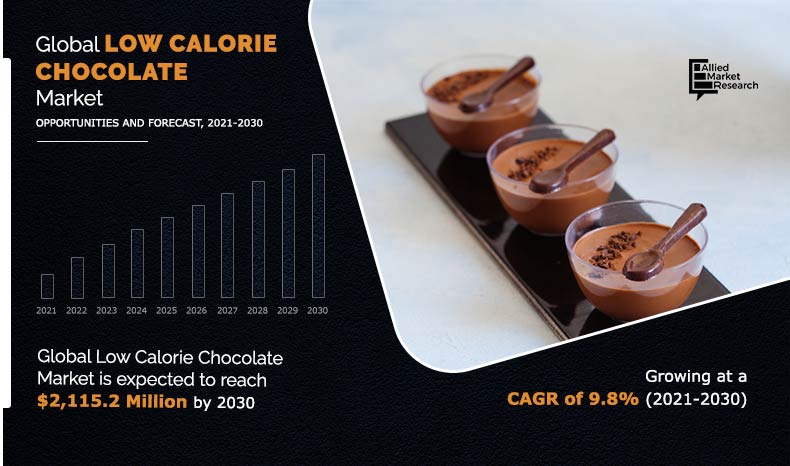The global low calorie chocolate market was estimated at $894.7 million in 2020 and is expected to hit $2.11 billion by 2030, registering a CAGR of 9.8% from 2021 to 2030. The report provides an in-depth analysis of the top investment pockets, top winning strategies, drivers & opportunities, market size & estimations, competitive scenario, and wavering market trends.
Growing popularity of low calorie food products and rising demand for healthy confectionery in the developed economies propel the growth of the global low calorie chocolate market. On the other hand, dynamic price fluctuations of cocoa beans and lack of awareness in the developing as well underdeveloped regions impede the growth to some extent. However, rising importance of organic food products is expected to create lucrative opportunities in the industry.
Download Sample PDF (307 Pages PDF with Insights): https://www.alliedmarketresearch.com/request-sample/14639
COVID-19 scenario-
Several travel restrictions and lockdown measures implemented by most of the government bodies during the pandemic led to a significant decline in the impulse buying and on-the-go consumption of low calorie chocolate, thereby impacting the global low calorie chocolate market negatively.
However, as the global situation has started getting better, the market is projected to recoup soon.
The global low calorie chocolate market is analyzed across product, source, distribution channel, and region.
Based on product, the dark segment accounted for the major share in 2020, holding nearly half of the global market. The milk segment, on the other hand, would grow at the fastest CAGR of 10.5% throughout the forecast period.
Request the Covid19 Impact Analysis @ https://www.alliedmarketresearch.com/request-for-customization/14639?reqfor=covid
Based on source, the conventional segment generated the highest share in 2020, accounting for 90% of the global market. The organic segment, however, is projected to manifest the fastest CAGR of 11.4% from 2021 to 2030 .
Based on region, the market across Europe held the lion’s share in 2020, garnering nearly two-fifths of the global market. The market across Asia-Pacific, simultaneously, is expected to cite the fastest CAGR of 10.8% by the end of 2030.
Interested in Procuring this Report? Visit Here: https://www.alliedmarketresearch.com/low-calorie-chocolate-market/purchase-options
The key market players analyzed in the global low calorie chocolate market report include Kraft Foods, The Hershey Company, Barry-Callebaut AG, Blommer Chocolate Company, Lindt & Sprungli, Ferrero SpA, Nestle S.A., Dreyer, Mondelez International, Breyers, Ben & Jerry’s, Haagen Daaz. These market players have incorporated several strategies including partnership, expansion, collaboration, joint ventures, and others to brace their stand in the industry.
Similar Reports:
Wine Chocolate Market Expected to Reach $1,473.4 Million by 2030
Wine Production Machinery Market is Expected to Reach $2.8 Billion by 2027
About Allied Market Research:
Allied Market Research (AMR) is a full-service market research and business-consulting wing of Allied Analytics LLP based in Portland, Oregon. Allied Market Research provides global enterprises as well as medium and small businesses with unmatched quality of “Market Research Reports” and “Business Intelligence Solutions.” AMR has a targeted view to provide business insights and consulting to assist its clients to make strategic business decisions and achieve sustainable growth in their respective market domains. AMR offers its services across 11 industry verticals including Life Sciences, Consumer Goods, Materials & Chemicals, Construction & Manufacturing, Food & Beverages, Energy & Power, Semiconductor & Electronics, Automotive & Transportation, ICT & Media, Aerospace & Defense, and BFSI.
We are in professional corporate relations with various companies and this helps us in digging out market data that helps us generate accurate research data tables and confirms utmost accuracy in our market forecasting. Each and every data presented in the reports published by us is extracted through primary interviews with top officials from leading companies of domain concerned. Our secondary data procurement methodology includes deep online and offline research and discussion with knowledgeable professionals and analysts in the industry.
